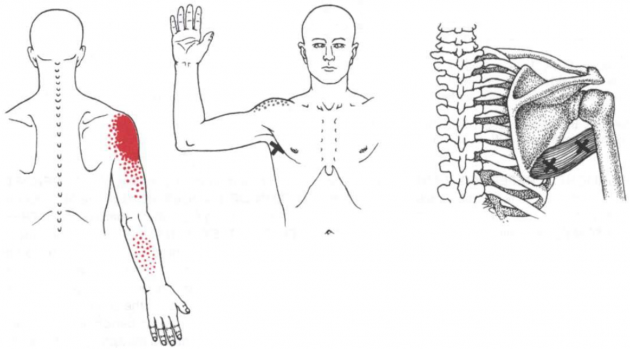Description
Teres major is a small muscle that runs along the lateral border of the scapula. It forms the inferior border of both the triangular space and quadrangular space.[1] It’s sometimes called “lat’s little helper” because of its synergistic action with the latissimus dorsi.[2]
Anatomy
Origin
- Posterior surface of the inferior angle of the scapula[5]
Insertion
- Medial lip of intertubercular suclus of humerus[5]
Nerve Supply
- Lower subscapular nerve[5]
Blood Supply
- Circumflex scapular artery[5]
Function
Actions
- Adducts and internally rotates the arm[5]
Functional contributions
- Active during extension of the arm from the flexed position[6]
- Assists the latissimus dorsi in wood-chopping movements[6]
- Forms a myotatic unit with latissimus dorsi and the long head of the triceps brachii for extension and internal rotation of the arm[6]
Trigger Point Referral Pattern
TrPs in teres major muscle typically refer pain into the posterior deltoid region and over the long head of the triceps brachii, as well as into the posterior shoulder joint, occasionally into the dorsal aspect of the forearm, and rarely into the scapula or elbow.[6]
Techniques
Palpation[2]
- With the patient in prone and arm off the side of the table, grasp latissimus dorsi between your fingers and thumb
- Move your fingers and thumb medially to the lateral boarder of the scapula
- Teres major muscle fibers lie medial to the latissimus and attach to the lateral boarder of the scapula
- Follow these fibers up towards the axilla where they blend with latissimus dorsi
Length Tension Testing / Stretching[7]
- With the patient in supine, flex the patient’s shoulder to 180deg with one hand by holding on the forearm
- Stabilize the scapula along the lateral boarder with the other hand
- With the hand holding the forearm, externally rotate the arm
- Both the moving hand and the hand stabilizing the scapula are used to sense the amount of muscle tension and barrier
Recent Related Research (from
Failed to load RSS feed from http://www.ncbi.nlm.nih.gov/entrez/eutils/erss.cgi?rss_guid=1tQjT4yH2iutFqE5V: There was a problem during the HTTP request: 422 Unprocessable Entity
Resources
References
- ↑ ↑ 2.02.1 Biel A (2005). Trail Guide to the Body (2nd ed). Boulder, CO: Books of Discovery.
- ↑ ↑ ↑ 5.05.15.25.35.4 Netter FH (2014). Atlas of Human Anatomy (6th ed). Philadelphia, PA: Saunders-Elsevier.
- ↑ 6.06.16.26.3 Travell JG, Simons DG, Simons LS (1998). Travell and Simons’ Myofascial Pain and Dysfunction: The Trigger Point Manual, Volume 2: The Upper Half of Body (2nd ed). Baltimore, MD: Williams & Wilkins.
- ↑ Sanzo P, MacHutchon M (2015). Length Tension Testing Book 2, Upper Quadrant: A Workbook of Manual Therapy Techniques (2nd ed). Canada: Brush Education.

